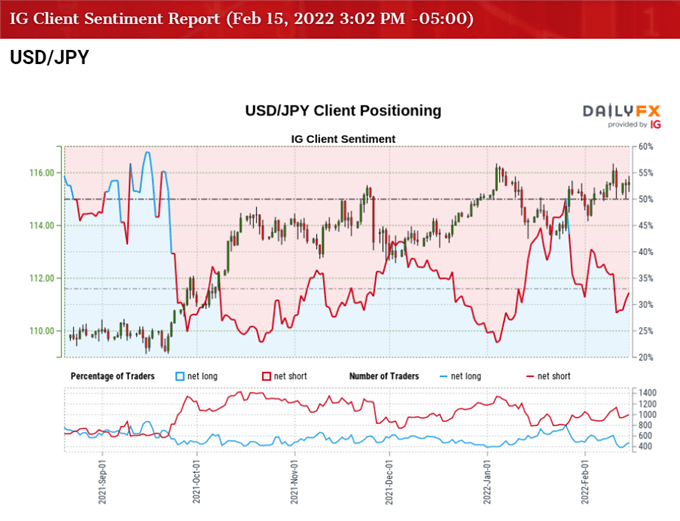Japanese Yen Talking Points
USD/JPY extends the advance from the start of the week to largely track the rise in longer-dated Treasury yields, and the exchange rate may stage another attempt to break out of the yearly opening range as the US Retail Sales report is anticipated to show a sharp rebound in household spending.
USD/JPY Stages Another Attempt for 2022 Opening Range Breakout
USD/JPY retraces the decline from the monthly high (116.34) as Federal Reserve officials show a greater willingness to normalize monetary policy sooner rather than later, and expectations for higher US interest rates may generate another run at the January high (116.35) as the Bank of Japan (BoJ) remains in no rush to switch gears.
As a result, the update to the US Retail Sales report may generate a bullish reaction in USD/JPY as private-sector consumption is anticipated to increase 2.0% in January, and a positive development may push the Federal Open Market Committee (FOMC) to further adjust the forward guidance for monetary policy as the central bank acknowledges that “the economy no longer needs sustained high levels of monetary policy support.”
In turn, the divergence paths between the FOMC and BoJ may keep USD/JPY afloat as the Fed looks to winddown its balance sheet in 2022, and it remains to be seen if Chairman Jerome Powell and Co. will project a steeper path for the Fed Funds rate as the central bank is slated to release the updated Summary of Economic Projections (SEP) at its next interest rate decision on March 16.
Until then, USD/JPY may stage further attempts to break out of the yearly opening range amid the rise in longer-dated Treasury yields, and a further rise in the exchange rate may fuel the tilt in retail sentiment like the behavior seen during the previous year.
The IG Client Sentiment report shows only 33.35% of traders are currently net-long USD/JPY, with the ratio of traders short to long standing at 2.00 to 1.
The number of traders net-long is 8.01% higher than yesterday and 11.45% lower from last week, while the number of traders net-short is 2.44% higher than yesterday and 0.85% lower from last week. The decline in net-long position could be a function of profit taking behavior as USD/JPY extends the advance from the start of the week, while the marginal decline in nets-short interest has helped to alleviate the tilt in retail sentiment as 29.43% of traders were net-long last week.
With that said, USD/JPY may continue to retrace the decline from the monthly high (116.34) as the Retail Sales report is expected to instill an improved outlook for growth, and the exchange rate may stage another run at the January high (116.35) amid the rise in US yields.
USD/JPY Rate Daily Chart
Source: Trading View
- The broader outlook for USD/JPY remains constructive as the 200-Day SMA (112.03) preserves the positive slope from last year, with the recent rally in the exchange rate negating the threat for a head-and-shoulders formation as it climbs to a fresh monthly high (116.34).
- However, the failed attempts to clear the January high (116.35) may generate a near-term correction in USD/JPY, and lack of momentum to hold above the 115.90 (100% expansion) to 116.10 (78.6% expansion) region may push the exchange rate back towards the Fibonacci overlap around 113.80 (23.6% expansion) to 114.30 (23.6% retracement), which lines up with the monthly low (114.15).
- Nevertheless, USD/JPY may stage further attempts to break out of the yearly opening rage as it initiates a fresh series of higher highs and lows, but need a close above the 115.90 (100% expansion) to 116.10 (78.6% expansion) region along with a break above the January high (116.35) to bring the topside targets back on the radar.
- A break out of the yearly opening range opens up the 117.60 (23.6% retracement) to 117.90 (23.6% retracement) region, with the next area of interest coming in around 118.90 (50% expansion).
— Written by David Song, Currency Strategist
Follow me on Twitter at @DavidJSong




Be the first to comment